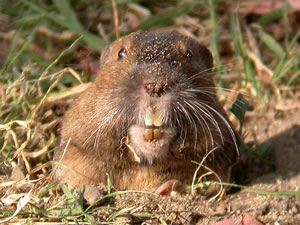How To Control Gophers
Gophers are notoriously difficult to get rid of. They burrow a foot or two below the surface and pop up all over. To add insult to injury they dine on many of the things we like to plant in our garden. We’ll discuss the various methods to rid your yard of gophers, ranging from humane to lethal.
First of all, let’s identify the creature. There are more than one type of burrowing rodents. The two most common are gophers (aka pocket gophers) and moles. You can tell the difference by how they mound their dirt. Gophers push their excavated dirt out through a hole and off to one side. A gopher mound always has most of the dirt on one side. On the other hand a mole pushes out the dirt and makes a cone, with their hole right in the middle, like a little volcano.
Since gophers are a force of nature, you might focus on protecting your garden rather than eliminating gophers. This option involves using wire mesh to create barriers to gophers. If you are installing a new lawn, consider the first layer, before soil amendments and compost, put down galvanized hardware cloth. It should be no more than six inches under ground and any digging that may be needed, such as trenches to install irrigation should be completed first. This will prevent the gopher from coming up through your new lawn. Instead they will hit the wire and be forced to go elsewhere.
To protect flower beds, it may not be practical to bury hardware cloth because of the occasional digging you will need to do when planting. You could bury the metal mesh deeper, but that might result in the gopher moving in above the metal and doing even worse damage to your garden. Another option is to instead trench around a garden to the depth of 24 inches allowing you to place a vertical barrier around the garden. A drawback is that for it to be fully effective the cloth must extend above the ground – ideally by 12 inches. Also, while gophers burrow mostly in the one to two foot zone, they have been known to go a few feet deeper. This fencing will likely reduce gopher traffic but cannot guarantee completely stopping them.
Flooding a gopher burrow is a common method of dealing with gophers, however it has its drawbacks. First of all, you may use hundreds of gallons of water in an attempt. If you are in draught conditions and water is rationed, this is not prudent choice (and possibly even illegal). Secondly, if you are hoping to simply drown the rodent, it may or may not work. If the ground absorbs the water quickly, there may be an airspace that occurs as quickly as the water flows in. Finally, there is a good chance the gopher will run out one of its many mounds. Are you ready to dispatch the gopher when it comes out?
Fumigating has been around for sometime and there are various products, such as aluminum phosphide, that can be used. Some areas may not allow the use of a toxic gas by anyone other than a licensed professional; so find out the local ordinances before attempting fumigation. A simple version of this technique is to cover all holes at each mound then insert a lit highway road flare into the last one. the flare burns at a high temperature, using up available oxygen and emits a poisonous gas. It is a simple technique that may or may not be effective depending upon who you ask. In theory it should work – in practical usage it did not work for us.
Poisoning gophers may be the simplest and most effective method, but it has serious drawbacks. The most common poisons are strychnine laced. Check local ordinances to make sure you can legally use poisoning to deal with gophers. One of the chief drawbacks is that if strychnine is dangerous to all animals and humans too. You don’t want it in the ground around your plants, you don’t want to use it where children can get at it and if a rodent does consume the poison and then leaves its burrow in a weakened state, it may potentially be eaten by a pet leading to its poisoning.
Application of poison is straightforward. First locate the main run, generally a straight line between two mounds. Use a metal rod such as rebar or steel pipe to probe the ground for the tunnel. When you poke through soil and then the probe drops an extra couple inches, you have located a burrow. Enlarge the hole just enough to insert a 1″ diameter pipe, and pour in some of the poison. You can make a funnel out of something like a paper plate and pour the poison into the funnel, down the pipe and directly into the burrow. Cover the hole, but avoid letting soil fall in and block the tunnel.
Trapping is more complicated, more work and may require a permit or may not be allowed in your community. The process involves locating a tunnel as described above. Two traps will be used near each mound. Dig a small trap sized hole no deeper than the burrow. Set the trap and place it into the burrow as directed in the manufacturer’s instructions. Cover the trap with a board to block up the hole completely. Check the trap every day or two. If you do not have success within a week, find another tunnel and repeat the process.

